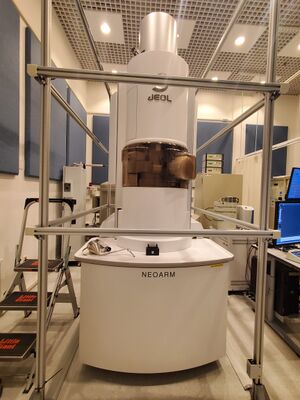Difference between revisions of "JEOL NEOARM"
(created page. overview, image. copied description from main Singh website) |
(added SOP link) |
||
| Line 13: | Line 13: | ||
| NEMO_Designation = JEOL NEOARM TEM-STEM | | NEMO_Designation = JEOL NEOARM TEM-STEM | ||
| Lab_Phone = XXXXX | | Lab_Phone = XXXXX | ||
| − | | SOP Link = | + | | SOP Link = [https://nemo.nano.upenn.edu/media/tool_documents/jeol-arm200cf-neoarm-tem/UPenn_NeoARM_Instrument_Procedures_1.0.pdf NEMO login required] |
}} | }} | ||
Latest revision as of 12:13, 14 February 2024
 |
|
| Tool Name | NEOARM |
|---|---|
| Instrument Type | S/TEM |
| Staff Manager | Douglas Yates |
| Lab Location | 010 |
| Tool Manufacturer | JEOL |
| Tool Model | NEOARM |
| NEMO Designation | JEOL NEOARM TEM-STEM |
| Lab Phone | XXXXX |
| SOP Link | NEMO login required |
Description
The JEOL NEOARM is a scanning / transmission electron microscope, equipped with a spherical aberration corrector for the probe-forming optics. This corrector has improved stability and optimizes 5th order aberrations, leading to an as-installed resolution of <0.63Å at 200kV, and a <1.92Å at 30kV. The instrument is a high-brightness cold field emission instrument.
Capabilities
It is equipped with two large area energy dispersive x-ray spectrometers that permit rapid atomic-resolution EDS mapping. It is equipped with a Gatan Image Filter, incorporating DualEELS capability to ensure accurate energy calibration and a K2-IS direct electron detector at the end of the filter. This detector has a detection quantum efficiency that is close to 1.0, and thus allows high sensitivity, leading to the detection of very high energy losses. The detector also allows 2k x 2k image acquisitions at 400 frames/second, and 512k x 2k image acquisitions at 1600 frames/second, making it optimal for in-situ/operando microscopy.
This JEOL NEOARM was the first to be installed in the U.S.
External Resources
For more information, check out the JEOL website